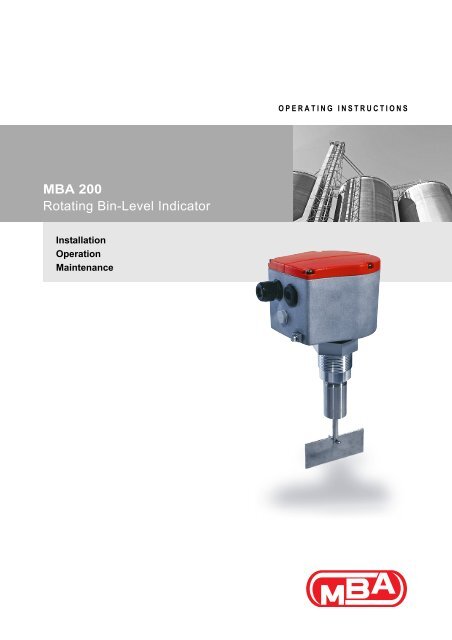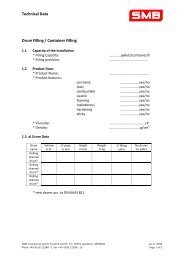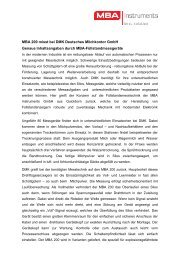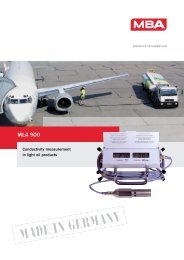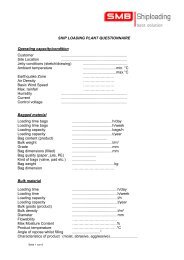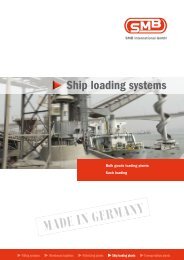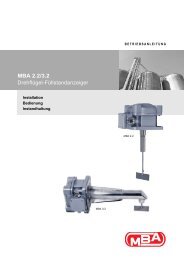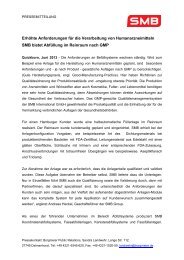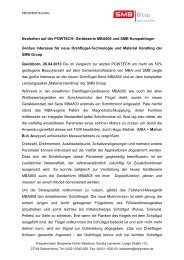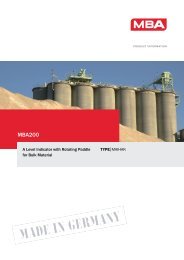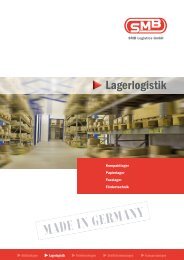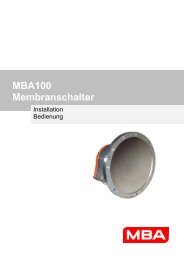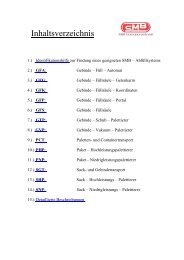MBA 200 Rotating Paddle - SMB Group
MBA 200 Rotating Paddle - SMB Group
MBA 200 Rotating Paddle - SMB Group
Create successful ePaper yourself
Turn your PDF publications into a flip-book with our unique Google optimized e-Paper software.
Title<br />
OPERATING<br />
INSTRUCTIONS<br />
<strong>MBA</strong> <strong>200</strong><br />
<strong>Rotating</strong> Bin-Level Indicator<br />
Installation<br />
Operation<br />
Maintenance
Bin-level Indicator <strong>MBA</strong> <strong>200</strong><br />
Document information<br />
Document ID<br />
Title: Operating Instructions <strong>MBA</strong> <strong>200</strong><br />
Order No.: 8011417<br />
Version: 2.2<br />
Stand: <strong>200</strong>9-05<br />
Subject<br />
Product name: <strong>MBA</strong> <strong>200</strong><br />
Hardware: all versions<br />
Manufacturer<br />
<strong>MBA</strong> Instruments GmbH<br />
Friedrich-List-Str. 5 · 25451 Quickborn · Germany<br />
© <strong>MBA</strong> Instruments GmbH Germany. All rights reserved.<br />
Explanation of warning symbols<br />
Hazard (general)<br />
Hazard by voltage<br />
Warning levels<br />
Hazard in explosion-hazardous locations<br />
Hazard by high temperature or hot surface<br />
CAUTION<br />
Hazard or unsafe practice which could result in personal injury or<br />
property damage.<br />
WARNING<br />
Risk or hazardous situation which could result in severe personal<br />
injury or death.<br />
Explanation of information symbols<br />
Technical risk for this device or its function (general)<br />
Technical risk for this device by voltage<br />
or other electrical hazards<br />
Supplementary information<br />
Nice to know<br />
Contents<br />
1 Product overview . . . . . . . . . . . . . . . . . . . . . . . . . . . . . . .3<br />
2 Product description . . . . . . . . . . . . . . . . . . . . . . . . . . . . .4<br />
2.1 Unit components . . . . . . . . . . . . . . . . . . . . . . . . . . . . . . . . .4<br />
2.2 Principle of operation . . . . . . . . . . . . . . . . . . . . . . . . . . . . . .4<br />
2.3 Optional equipment . . . . . . . . . . . . . . . . . . . . . . . . . . . . . . .4<br />
2.4 Appropriate use . . . . . . . . . . . . . . . . . . . . . . . . . . . . . . . . . .4<br />
2.5 Responsibility of the user . . . . . . . . . . . . . . . . . . . . . . . . . .4<br />
3 Installation . . . . . . . . . . . . . . . . . . . . . . . . . . . . . . . . . . . .5<br />
3.1 Protective roof / deflector . . . . . . . . . . . . . . . . . . . . . . . . . . .5<br />
3.2 Assembly (if required) . . . . . . . . . . . . . . . . . . . . . . . . . . . . .5<br />
3.3 Installation . . . . . . . . . . . . . . . . . . . . . . . . . . . . . . . . . . . . . .6<br />
3.3.1 Operational conditions . . . . . . . . . . . . . . . . . . . . . . . . . . .6<br />
3.3.2 Installation position . . . . . . . . . . . . . . . . . . . . . . . . . . . . .6<br />
3.3.3 Attachment . . . . . . . . . . . . . . . . . . . . . . . . . . . . . . . . . . .6<br />
3.3.4 Temperatures of the distance tube . . . . . . . . . . . . . . . . .7<br />
3.4 Electrical connection . . . . . . . . . . . . . . . . . . . . . . . . . . . . . .7<br />
3.4.1 Important safety notes . . . . . . . . . . . . . . . . . . . . . . . . . .7<br />
3.4.2 Safe electrical installation . . . . . . . . . . . . . . . . . . . . . . .7<br />
3.4.3 Protection against explosion . . . . . . . . . . . . . . . . . . . . . .7<br />
3.4.4 Type 210 (115 or 230 VAC) . . . . . . . . . . . . . . . . . . . . . . .8<br />
3.4.5 Type 220 (24 VAC/DC) . . . . . . . . . . . . . . . . . . . . . . . . . .8<br />
3.4.6 Type 230 (42/115/230 VAC) . . . . . . . . . . . . . . . . . . . . . .9<br />
3.5 DIP switch settings for type 220/230 . . . . . . . . . . . . . . . . .9<br />
3.6 Closing the housing . . . . . . . . . . . . . . . . . . . . . . . . . . . . . . .9<br />
3.6.1 Closing the cable glands . . . . . . . . . . . . . . . . . . . . . . . . .9<br />
3.6.2 Closing the cover . . . . . . . . . . . . . . . . . . . . . . . . . . . . . . .9<br />
4 First Start-up . . . . . . . . . . . . . . . . . . . . . . . . . . . . . . . . . .10<br />
4.1 Switching on . . . . . . . . . . . . . . . . . . . . . . . . . . . . . . . . . . .10<br />
4.2 Function test at first start-up . . . . . . . . . . . . . . . . . . . . . . .10<br />
4.2.1 Check the operative function . . . . . . . . . . . . . . . . . . . . .10<br />
4.2.2 Check for triggering by the bulk material . . . . . . . . . . . .10<br />
5 Maintenance . . . . . . . . . . . . . . . . . . . . . . . . . . . . . . . . . .10<br />
5.1 Recommended maintenance work . . . . . . . . . . . . . . . . . .10<br />
5.2 Preventive function check . . . . . . . . . . . . . . . . . . . . . . . . .10<br />
5.3 Safety information on opening . . . . . . . . . . . . . . . . . . . . .10<br />
5.4 Removing the unit head (repair note) . . . . . . . . . . . . . . . .10<br />
6 Fault indication . . . . . . . . . . . . . . . . . . . . . . . . . . . . . . .11<br />
7 Technical data . . . . . . . . . . . . . . . . . . . . . . . . . . . . . . . .11<br />
7.1 Specifications on the nameplate . . . . . . . . . . . . . . . . . . . .11<br />
7.2 Electrical data . . . . . . . . . . . . . . . . . . . . . . . . . . . . . . . . . .11<br />
7.3 Ambient conditions . . . . . . . . . . . . . . . . . . . . . . . . . . . . . .11<br />
7.4 Product materials . . . . . . . . . . . . . . . . . . . . . . . . . . . . . . . .11<br />
7.5 Dimensions . . . . . . . . . . . . . . . . . . . . . . . . . . . . . . . . . . . .12<br />
7.6 EC-Type Examination Certificate . . . . . . . . . . . . . . . . . . .13<br />
2<br />
<strong>MBA</strong> <strong>200</strong> · Operating Instructions 8011417 V 2.2 · © <strong>MBA</strong> Instruments GmbH Germany
Bin-level Indicator <strong>MBA</strong> <strong>200</strong><br />
1 Product overview<br />
<br />
<br />
<br />
<br />
<br />
<br />
<br />
<br />
<br />
<br />
<strong>MBA</strong> <strong>200</strong> · Operating Instructions 8011417 V2.2 · © <strong>MBA</strong> Instruments GmbH Germany 3
Bin-level Indicator <strong>MBA</strong> <strong>200</strong><br />
2 Product description<br />
2.1 Unit components<br />
1. Unit head: contains the motor<br />
drive and electronic components.<br />
Three different types available.<br />
2. Process connection: thread or<br />
flange. Attached to the outer wall<br />
of the bulk materials container.<br />
Holds the unit head on the<br />
outside and the protective tube (if<br />
provided) on the inside. Many<br />
versions available for individual<br />
adaptation to the actual container.<br />
3. Shaft: Connects the paddle to the<br />
unit head. Various lengths<br />
available (large sizes divided in<br />
two sections) and a flexible steel cable as the shaft.<br />
4. <strong>Paddle</strong>: Stops the shaft rotation when the bulk material<br />
surrounds the paddle. Solid/flexible/foldable versions<br />
available with different size or material.<br />
5. Protective tube (option): Covers the shaft inside the<br />
container. Various lengths available. Versions: open tube<br />
for vertical mounting (great lengths delivered in two<br />
sections); tube for horizontal mounting with additional<br />
shaft bearing at the end; angled shaft bearing with<br />
horizontal tube and a vertical shaft.<br />
2.2 Principle of operation<br />
The electric motor in the head makes the shaft and the<br />
paddle rotate slowly. When the bulk material surrounds the<br />
paddle, the rotation is blocked. The counter-torque is used to<br />
turn the motor mechanism against a switch which then turns<br />
the motor off. The switch has a second contact (potentialfree)<br />
which is used for the status indication.<br />
As soon as the bulk material releases the paddle again, a<br />
spring pulls the motor mechanism back into the working<br />
position. Thus the switch is released and the paddle starts<br />
rotating again.<br />
The motor mechanism requires approximately 3 seconds to<br />
indicate stopping or restarting of the paddle (switching delay<br />
due to the mechanical sequence).<br />
Additional indication delay can be effected by<br />
● the characteristics of the bulk material<br />
● torsion effects (e.g. cable shaft, rubber paddle)<br />
● electronic switching delay (→ page 9, § 3.5)<br />
2.3 Optional equipment<br />
General options<br />
● Special seal (DTR): Protection against gases, vapours,<br />
and abrasive bulk materials.<br />
● Compensating membrane: Membrane which allows<br />
diffusion of water-vapour and thus can balance out the<br />
humidity inside the unit head. Moreover, the membrane<br />
will burst if the pressure inside the unit head increases<br />
strongly due to operational trouble, which allows the use<br />
on containers with an internal pressure up to +1 MPa<br />
(option »10 bar«).<br />
● Heating in the unit head: Allows use at low ambient<br />
temperatures.<br />
● Height adjustment: A clamping sleeve which guides the<br />
protective tube of the extension arm and allows fixating<br />
the extension arm at variable insertion depth.<br />
Electronic options (only for type 220 and 230)<br />
● Action monitoring: A Hall sensor in the unit head<br />
monitors the shaft rotation. The error status is indicated<br />
by means of a relay contact.<br />
● Indicating LED light: Indicates the current status.<br />
1<br />
2<br />
3<br />
4<br />
5<br />
2.4 Appropriate use<br />
Range of application<br />
<strong>MBA</strong> bin level indicators are rugged electromechanical<br />
sensors, designed to detect the presence of bulk material at<br />
the place of installation and thus to control the filling of bulk<br />
material containers. Possible applications depend on the<br />
configuration of the individual unit.<br />
Bin level indicators of the <strong>MBA</strong> <strong>200</strong> series can be used with<br />
industrial bulk materials from organic and mineral<br />
substances. <strong>MBA</strong> units may not be affected by chemical<br />
aggressive gases or fluids.<br />
WARNUNG: Explosion hazard<br />
A <strong>MBA</strong> <strong>200</strong> bin level indicator may only be used in<br />
explosion-hazardous locations if the individual<br />
specifications of the unit complies with this use.<br />
Check nameplate and accompanying papers.<br />
Check whether the specifications of the EC-Type<br />
Examination Certificate must be complied with<br />
(→ page 13, § 7.6).<br />
If there is any doubt whether the unit may be used for<br />
the desired application or not: Ask the manufacturer.<br />
Design options<br />
Variable design features are, for example:<br />
● <strong>Paddle</strong> design, size, and material<br />
● Shaft design and material<br />
● Sealing of shaft against enclosure<br />
The corresponding properties for the unit can expand or<br />
restrict the range of possible applications (e.g. suitability for<br />
a particular type of bulk material). Please note carefully the<br />
specifications for your particular unit.<br />
2.5 Responsibility of the user<br />
Use the device only as described in these Operating<br />
Instructions. The manufacturer bears no responsibility for<br />
any other use.<br />
In addition to these Operating Instructions, follow all local<br />
laws, technical rules and company-internal operating<br />
directives applicable at the respective installation site of<br />
the equipment.<br />
No components may be removed from, added to or<br />
changed on the device unless this is described and<br />
specified in the official manufacturer information.<br />
In explosion-hazardous locations: Prior to installation and<br />
operation, observe the European standard EN 61241-14.<br />
EN 61241-14: Electrical apparatus for use in the presence<br />
of combustible dust – selection and installation.s<br />
Product versions which are certified for use in explosionhazardous<br />
locations have been tested and certified<br />
according to EN 61241-0 and EN 61241-1.<br />
4<br />
<strong>MBA</strong> <strong>200</strong> · Operating Instructions 8011417 V 2.2 · © <strong>MBA</strong> Instruments GmbH Germany
Bin-level Indicator <strong>MBA</strong> <strong>200</strong><br />
3 Installation<br />
Do not remove, add, or change any of the components<br />
in the instrument unless these changes are described<br />
and specified in a manufacturer’s official information.<br />
Otherwise the manufacturer’s guarantee becomes invalid,<br />
and the certification for use in explosion-hazardous<br />
locations (if provided) is no longer valid.<br />
3.1 Protective roof / deflector<br />
If at all possible, place the Maihak<strong>MBA</strong> unit in a position<br />
where falling bulk material will not directly strike onto the<br />
shaft or the paddle.<br />
For heavy bulk materials that could damage the shaft or the<br />
paddle:<br />
If required, install a stable deflector or protective roof in<br />
the container which protects the shaft and the paddle<br />
against direct impact of falling bulk material.<br />
3.2 Assembly (if required)<br />
If shaft, paddle, and protective tube (if provided) were<br />
shipped dismantled (for safe and easy transport):<br />
Install the shaft: Guide the top end of the shaft into the<br />
shaft sleeve of the unit head. Use a split-pin to connect<br />
both parts (push it through and spread it out). – With twopart<br />
shafts: Join both parts of the shaft in the same way.<br />
Assembling the protective tube (for divided protective<br />
tubes): Take the locking screws out of the connecting<br />
coupling sleeve. Screw one of the protective tube parts<br />
into the coupling sleeve – up to about the middle of the<br />
coupling sleeve. Then screw-in the other part from the<br />
other side and firmly attach both parts of the protective<br />
tube. – Recommendation: Now make two small<br />
countersunk holes in the coupling sleeve, which will fix<br />
the position of the locking screws (use a max. 3.2 mm<br />
diameter drill guided through the screw holes of the<br />
coupling sleeve). – Put in the locking screws and tighten.<br />
Install the protective tube (for units with a protective<br />
tube): Apply a threadlocking adhesive (such as »Loctite«)<br />
to the thread of the protective tube and screw the<br />
protective tube into the threaded sleeve, as far as it goes.<br />
Shortening the flexible cable shaft (if required): Remove<br />
the tensioning weight from the end of the cable (undo the<br />
locking screw and pull out the cable). At the place where<br />
the cable must be cut, wrap some adhesive tape firmly<br />
around the cable, to protect against wire particles<br />
shooting from the cable. Wear protective goggles/<br />
glasses. Then cut the cable with a suitable wire cutter or<br />
a cutting disk. Remove the adhesive tape and attach the<br />
tensioning weight again.<br />
Install the paddle: Guide the flat end of the paddle into<br />
the slot of the shaft and attach it with the split-pin<br />
provided (push it through and spread it out).<br />
1.<br />
1.<br />
5.<br />
6.<br />
2.<br />
If the bulk material is heavy or can form large clumps:<br />
Install a stable protective roof within the container to<br />
shield the shaft (and the extension arm) from the weight<br />
of the bulk material.<br />
Provide sufficient space between protective roof and<br />
paddle to make sure that the bulk material can reach the<br />
paddle.<br />
2.<br />
3.<br />
4.<br />
1<br />
3.<br />
2.<br />
7.<br />
1 … 7 = order of assembly<br />
●<br />
●<br />
It may be necessary (or advantageous) to install the<br />
paddle at the very end of the installation procedure.<br />
Recommendation: Apply a threadlocking adhesive<br />
(such as »Loctite«) to all the locking screws.<br />
<strong>MBA</strong> <strong>200</strong> · Operating Instructions 8011417 V2.2 · © <strong>MBA</strong> Instruments GmbH Germany 5
Bin-level Indicator <strong>MBA</strong> <strong>200</strong><br />
3.3 Installation<br />
3.3.1 Operational conditions<br />
Observe temperature specifications on the nameplate<br />
(example → page 11, § 7.1, explanations → page 4, § 2.4).<br />
Keep the following pressure limits:<br />
Standard configuration<br />
Version D10 (equipped<br />
with burst membrane in the<br />
unit head)<br />
In explosion-hazardous<br />
locations<br />
3.3.2 Installation position<br />
Units without additional shaft bearing in the extension<br />
arm: Use only with a vertically suspended shaft (±5°).<br />
Exception: If the shaft is rigid (not flexible) and not longer<br />
than <strong>200</strong> mm and the bulk material is light-weighted, an<br />
angle of inclination of max. 90° is permissible (allows sidemounting<br />
with horizontal shaft).<br />
<br />
–50 … +300 kPa<br />
(–0.5 … +3.0 bar)<br />
max. 1.0 MPa (10 bar)<br />
80 … 110 kPa<br />
(0.8 … +1.1 bar)<br />
<br />
3.3.3 Attachment<br />
Standard versions<br />
Attach the <strong>MBA</strong> process connection to the container.<br />
(dimensions → page 12, § 7.5).<br />
If protection class IP 65 is required (European standard<br />
EN 60529): Provide a suitable water/dust sealing<br />
between device and container.<br />
If the paddle does not go through the container opening:<br />
Detach the paddle before mounting and re-install after<br />
mounting.<br />
Height adjustment (option)<br />
The height adjustment device is a clamp-ring fitting which<br />
allows to fix the protective tube at variable insertion depth.<br />
1. Install the threaded base part of the fitting in the container<br />
wall.<br />
2. Put the clamping nut and the clamping ring over the<br />
protective tube.<br />
3. Guide the protective tube through the base part of the<br />
fitting (caution: do not damage the sealing rings inside<br />
the fitting) and bring it into the desired position.<br />
4. Guide the clamping ring into the fitting. Screw-up and<br />
tighten the clamping nut.<br />
5. Install the paddle.<br />
<br />
In case of lateral installation (horizontal shaft): Install the<br />
unit in such a way that the cable glands are on the<br />
underside of the housing.<br />
The unit head can be turned (2) after the clamping screw (1)<br />
on the underside has been released.<br />
1<br />
2<br />
The clamping screw must be fixed to achieve operational<br />
condition.<br />
Temperature protection by height adjustment<br />
The height adjustment device can also be used to keep the<br />
unit head away from high container temperatures.<br />
● Important: This feature applies only to units equipped<br />
with »DTR« type bearings.<br />
Mounting instructions:<br />
Adjust the height to a level where the distance between<br />
unit head and container is at least <strong>200</strong> mm (7.9").<br />
If the container is equipped with a thermal insulation:<br />
Remove the thermal insulation around the protective tube<br />
(instructions → page 7, § 3.3.4).<br />
When these conditions are kept, the unit can be used with<br />
container temperatures up to <strong>200</strong> °C (392 °F).<br />
6<br />
<strong>MBA</strong> <strong>200</strong> · Operating Instructions 8011417 V 2.2 · © <strong>MBA</strong> Instruments GmbH Germany
Bin-level Indicator <strong>MBA</strong> <strong>200</strong><br />
3.3.4 Temperatures of the distance tube<br />
Unit versions for high container temperatures above 80 °C<br />
are equipped with a distance tube between unit head and<br />
connection thread/flange. The purpose of the distance tube<br />
is to keep high temperatures away from the unit head (max.<br />
60 °C).<br />
If the container is equipped with a thermal insulation:<br />
Keep the distance tube free of thermal insulation, in order<br />
to allow cooling by the ambient air. Do not cover the<br />
distance tube with the insulation of the container.<br />
Otherwise distance tube will not provide the required<br />
cooling effect. Overheat can cause malfunctions and<br />
damage the unit head.<br />
3.4 Electrical connection<br />
3.4.1 Important safety notes<br />
WARNUNG: Free electrical contacts inside the unit head<br />
Before opening the unit head, shut off the mains power<br />
supply and all connected signal voltage. The electrical<br />
circuits inside the unit head are not protected against<br />
physical contact.<br />
WARNUNG: High voltage inside the unit head (type 230)<br />
In the type 230 unit head, there are always contacts with an<br />
output of 230 and 115 V, even if the unit is powered with a<br />
lower voltage (→ page 9, § 3.4.6).<br />
Observe this information when operating the unit with<br />
open unit head for service purposes. Take care. Give a<br />
warning to other persons.<br />
3.4.2 Safe electrical installation<br />
A <strong>MBA</strong> <strong>200</strong> should be installed and set-up by skilled<br />
persons who can assess the tasks given and consider<br />
the dangers involved.<br />
WARNUNG: Risk of injury<br />
The distance tube is possibly hot enough to burn skin<br />
immediately when being touched.<br />
If the container is hot: Protect the distance tube against<br />
accidental touching.<br />
WARNUNG: Explosion hazard by dust contamination<br />
The surface temperature of the distance tube can be<br />
significantly higher than the unit head temperature.<br />
Check if the dust-explosion limit value can be exceeded<br />
when the surface of the distance tube is covered with<br />
dust.<br />
If this hazard exists: Make sure that the distance tube<br />
cannot be contaminated with dust, or that the distance<br />
tube is periodically cleaned as a preventive measure.<br />
The <strong>MBA</strong> <strong>200</strong> is not equipped with a power switch or fuse.<br />
Install an external power switch which can switch on and<br />
off the mains power supply to the <strong>MBA</strong> <strong>200</strong>.<br />
Provide an external mains fuse for the <strong>MBA</strong> <strong>200</strong> (power<br />
consumption → page 11, § 7.2).<br />
Use power cable with following conductor cross sections:<br />
– Massive wire: max. 2,5 mm²<br />
– Stranded wire: max. 1,5 mm²<br />
Use cables which are specified for an ambient<br />
temperature of at least 60 °C (140 °F).<br />
Protect all cables against heat. Avoid contact with hot<br />
surfaces (for example, the container wall). Consider<br />
thermal radiation and heat accumulation.<br />
3.4.3 Protection against explosion<br />
WARNUNG: Explosion hazard<br />
If the unit is used in an explosion-hazardous location,<br />
the following criteria must be observed:<br />
Certification:<br />
– Check if the individual unit is applicable to the use in<br />
the actual explosion-hazardous location (see<br />
nameplate and delivered documents).<br />
– Observe the „special conditions“ which are specified<br />
in certification documents.<br />
Equipotential connection: In addition to the protective<br />
earth connection (PE), install an equipotential bonding,<br />
using the terminal on the outside of the unit head.<br />
Cables: Use only cables which fit to the cable glands. For<br />
standard product versions, the outer diameter of the<br />
cables must be 6 … 12 mm.<br />
Cable glands: The built-in cable glands may only be<br />
replaced by components which are certified for the use in<br />
the actual explosion-hazardous location (ATEX-certified).<br />
Fixed installation: Fix all connected cables in place over<br />
their entire length.<br />
Sparks: Prevent generation of sparks inside the<br />
container. Sparks can be generated when the shaft or the<br />
paddle collides with metal parts. If the Maihak<strong>MBA</strong> is<br />
equipped with a flexible shaft, sparks could be produced<br />
when the shaft cable swings and the paddle collides with<br />
the container wall.<br />
Installation standard: Make the installation in accordance<br />
to the European standard EN 61241-14.<br />
<strong>MBA</strong> <strong>200</strong> · Operating Instructions 8011417 V2.2 · © <strong>MBA</strong> Instruments GmbH Germany 7
Bin-level Indicator <strong>MBA</strong> <strong>200</strong><br />
3.4.4 Type 210 (115 or 230 VAC)<br />
3.4.5 Type 220 (24 VAC/DC)<br />
<br />
<br />
<br />
<br />
<br />
<br />
<br />
<br />
<br />
<br />
<br />
<br />
<br />
<br />
<br />
<br />
<br />
<br />
<br />
<br />
<br />
<br />
<br />
<br />
<br />
<br />
<br />
<br />
<br />
<br />
<br />
<br />
<br />
<br />
<br />
<br />
<br />
<br />
<br />
<br />
<br />
<br />
<br />
<br />
<br />
<br />
Signal contact<br />
Use the potential-free make&break relay contact K1 for<br />
the level indication.<br />
Depending on setting of S1, relay K1 is activated either when<br />
the paddle is rotating or when the paddle is stopped.<br />
Select which setting provides a fail-safe operation in your<br />
system:<br />
S1<br />
Position H<br />
Fail-safe FULL level<br />
indication:<br />
K1 is activated when the<br />
paddle is rotating.<br />
During power failure, the<br />
»full« status is indicated<br />
(like paddle is stopped).<br />
Status output<br />
S3 switches the power voltage (L1) between terminal 4 and<br />
5, directly actuated by the motor mechanism.<br />
Permissible contact load<br />
Direct current: 60 VDC, 1 A (DC 1)<br />
Alternating current: 250 VAC, 2 A (AC 15)<br />
Power supply<br />
Mains supply voltage:<br />
115 VAC or 230 VAC<br />
(see nameplate)<br />
–15 %/+10 %<br />
Connect the power supply to terminals L1 and N.<br />
Connect the protective earth (PE) conductor to the<br />
terminal in the unit head.<br />
Overheat fuse<br />
Type 210 is equipped with an overheat fuse which cuts off<br />
the power supply when the internal temperature exceeds<br />
98 °C (208 °F). When the fuse is blown, the electronics<br />
board needs to be replaced for repair.<br />
Wiring example as FULL level indicator<br />
Position L<br />
Fail-safe EMPTY level<br />
indication:<br />
K1 is activated when the<br />
paddle is stopped.<br />
During power failure, the<br />
»empty« status is<br />
indicated (like paddle is<br />
rotating).<br />
Overvoltage can immediately destroy internal electronic<br />
components.<br />
Observe the mains voltage specification on the<br />
nameplate (→ page 11, § 7.1).<br />
Signal contact<br />
Use make&break relay contact K1 for the level indication<br />
(paddle rotating / stopped). Depending on setting of S1-1,<br />
relay K1 is activated either when the paddle is rotating or<br />
when the paddle is stopped.<br />
Select which setting provides a fail-safe operation in your<br />
system (→ §3.5).<br />
Status contact<br />
Relay contact K2 is used to indicate a fault condition. Full<br />
information → page 11, § 6.<br />
Permissible contact load<br />
Direct current: 60 VDC, 1 A (DC 1)<br />
Alternating current: 250 VAC, 2 A (AC 15)<br />
Power supply<br />
Permissible power supply voltage:<br />
Direct current: 24 VDC –10 %/+30 %<br />
Alternating current: 24 VAC –15 %/+10 %<br />
Provide an external power fuse.<br />
Connect the power supply to terminals »24 V« (+) and<br />
»0 V« (–).<br />
Connect the protective earth (PE) conductor to the<br />
terminal in the unit head.<br />
Power overload fuse<br />
The power overload fuse cuts off the internal power supply<br />
in case of high current.<br />
When overload fuse has been released: Switch off the<br />
power supply externally and wait for approximately one<br />
minute for the fuse to cool down; then switch on the<br />
power supply again.<br />
If the overload fuse is released again: Search for the<br />
trouble; or replace the electronics board, if required.<br />
Overheat fuse<br />
The overheat fuse cuts off the power supply when the<br />
internal temperature exceeds 98 °C (208 °F). When this fuse<br />
is blown, the electronics board needs to be replaced for<br />
repair.<br />
L1<br />
L1<br />
3<br />
<strong>MBA</strong><br />
210<br />
K1<br />
H<br />
S1<br />
N<br />
1 2<br />
N<br />
fill control<br />
8<br />
<strong>MBA</strong> <strong>200</strong> · Operating Instructions 8011417 V 2.2 · © <strong>MBA</strong> Instruments GmbH Germany
Bin-level Indicator <strong>MBA</strong> <strong>200</strong><br />
3.4.6 Type 230 (42/115/230 VAC)<br />
<br />
<br />
<br />
<br />
<br />
<br />
<br />
<br />
<br />
Signal contact<br />
See type 220.<br />
Status contact<br />
See type 220.<br />
<br />
<br />
Permissible contact load<br />
See type 220.<br />
<br />
<br />
<br />
<br />
<br />
<br />
<br />
<br />
Power supply<br />
Provide an external power fuse.<br />
For 115 or 230 V power voltage: Connect L1 conductor<br />
to terminal »115« or »230«, respectively. Connect N<br />
conductor to terminal »N«.<br />
For 42 V power voltage: Connect L1 conductor to<br />
terminal »42«. Connect N conductor to terminal »0«.<br />
Connect the protective earth (PE) conductor to the<br />
terminal in the unit head.<br />
WARNUNG: Internally generated power voltage<br />
The power terminals »230« and »115« will have a voltage<br />
output of 230/115 V, even if the unit is used with a lower<br />
power voltage (due to power feedback through internal<br />
transformer).<br />
Observe this information when operating the unit with<br />
open unit head for service purposes. Take care. Give a<br />
warning to other persons.<br />
<br />
<br />
<br />
<br />
<br />
<br />
<br />
<br />
3.5 DIP switch settings for type 220/230<br />
S1 ON OFF<br />
1 Fail-safe FULL indication:<br />
K1 is activated when the<br />
paddle is rotating. During<br />
power failure, the »full«<br />
status is indicated (like<br />
paddle is stopped).<br />
Fail-safe<br />
EMPTY indication: K1 is<br />
activated when the paddle<br />
is stopped. During power<br />
failure, the »empty« status<br />
is indicated (like paddle is<br />
rotating).<br />
2 Switch-on delay: K1<br />
switches on with a delay of<br />
No electronic switch-on<br />
delay.<br />
4s.<br />
3 Switch-off delay: K1<br />
switches off with a delay of<br />
4s.<br />
No electronic switch-off<br />
delay.<br />
4 The action monitoring<br />
option is built-in<br />
(consequences → page 11,<br />
»Fault indication«).<br />
3.6 Closing the housing<br />
3.6.1 Closing the cable glands<br />
Lay the connected cables internally in such a way that<br />
they do not interfere with the mechanism.<br />
After the cables have been installed, the cable glands<br />
must be closed-off to be dust-tight and spray-water<br />
resistant.<br />
Unused cable glands must either be blocked-off with<br />
stoppers or replaced with closing caps. If used in<br />
explosion-hazardous locations, these parts must be<br />
applicable to explosion-hazardous locations (ATEXcertified).<br />
3.6.2 Closing the cover<br />
The action monitoring<br />
option is not built-in.<br />
Before closing cover of the unit head, check whether<br />
there are any foreign bodies inside the unit head (such as<br />
rests of cable). Remove them.<br />
Visually check the sealing of the cover. Clean or replace if<br />
necessary.<br />
Put the cover in place and screw it up tight.<br />
Permissible power voltage tolerance: –15 %/+10 %<br />
Internal fuses<br />
Type 220 is equipped with three internal fuses:<br />
● Power overload fuse: see type 220.<br />
● Overheat fuse: see type 220.<br />
● Overheat fuse in the power transformer: cuts off the<br />
transformer circuit at 98 °C (208 °F).<br />
<strong>MBA</strong> <strong>200</strong> · Operating Instructions 8011417 V2.2 · © <strong>MBA</strong> Instruments GmbH Germany 9
Bin-level Indicator <strong>MBA</strong> <strong>200</strong><br />
4 First Start-up<br />
4.1 Switching on<br />
WARNUNG: Health risk / Explosion hazard<br />
During operation, the unit head and the cable gland(s) must<br />
be correctly closed and sealed. Otherwise the specified<br />
type of protection and the specified explosion protection<br />
(option) is not guaranteed.<br />
4.2 Function test at first start-up<br />
4.2.1 Check the operative function<br />
After the first start-up, check the indicating function:<br />
1. Allow the paddle to rotate freely: check the »empty«<br />
indication.<br />
2. Stop the paddle by hand: check the »full« indication.<br />
4.2.2 Check for triggering by the bulk material<br />
Procedure<br />
While visually watching the bulk material level, fill and<br />
empty the bulk materials container up to the <strong>MBA</strong> unit,<br />
and check that the indicating function is correctly<br />
triggered. This test should be made several times.<br />
If the <strong>MBA</strong> unit does not correctly indicate the level<br />
status: Check the options for mechanical adaptation (see<br />
below) and carry them out if necessary.<br />
If the type of bulk material has been changed:<br />
Do this test/adaptation again.<br />
Possible ways of adapting the unit<br />
● Spring tension (see figure):<br />
– More sensitive setting (less tension), for light bulk<br />
material: Bring the spring to closer position.<br />
– Less sensitive setting (more tension), for heavy bulk<br />
material: Bring the spring to a more distant position.<br />
● <strong>Paddle</strong> size:<br />
– To make it more sensitive (for lighter bulk material):<br />
Install a bigger paddle.<br />
– To make it less sensitive: Install a smaller paddle.<br />
● Spring type: If required, install a stronger or weaker<br />
spring (3 different types available).<br />
5 Maintenance<br />
5.1 Recommended maintenance work<br />
Clean the moving external parts: Clean off deposits and<br />
dirt on paddle and shaft, using a (soft) scraper and/or a<br />
brush. Do not use force. Caution: Do not damage the<br />
shaft sealing. Do not allow bristles to get between the<br />
shaft and the shaft sealing.<br />
Inspect the parts subject to wear (highly recommended<br />
in case of abrasive bulk material): Make a visual<br />
inspection of the parts which protrude into the container<br />
(shaft, paddle, etc.). Pay special attention to the<br />
connecting parts (split-pins, etc.). Replace damaged or<br />
dubious parts.<br />
Clean the protective tube (only if the unit is equipped<br />
with an open protective tube): Clean the inside of the<br />
protective tube to make sure that the shaft can always<br />
freely rotate.<br />
Clean the distance tube (if existing – if required for<br />
explosion protection → page 7, § 3.3.4): Remove dust<br />
contamination from the distance tube.<br />
5.2 Preventive function check<br />
If the indicating function is seldom triggered during operation<br />
(e.g. if the level indicator is used as a safety switch):<br />
1. Inform the connected stations that a test will be carried<br />
out.<br />
2. Stop the paddle by hand / allow the paddle to rotate<br />
freely, and check the correct status indication.<br />
5.3 Safety information on opening<br />
WARNUNG: Health risk / Explosion hazard<br />
Before opening the unit head: switch-off the power<br />
supply and any connected signal voltage at an external<br />
point. (Note: the level indication is thereby disabled.)<br />
Only open the housing when you are absolutely sure<br />
that there is no possible danger.<br />
WARNUNG: High voltage inside the unit head (type 230)<br />
In the type 230 unit head, there are always contacts with an<br />
output of 230 and 115 V, even if the unit is powered with a<br />
lower voltage (→ page 9, § 3.4.6).<br />
Observe this information when operating the unit with<br />
open unit head for service purposes. Take care. Give a<br />
warning to other persons.<br />
Severe dirtiness inside the unit head can affect the proper<br />
functioning of the unit.<br />
Protect the inside of the unit head from getting dirty.<br />
5.4 Removing the unit head (repair note)<br />
The unit head can easily be separated from the process<br />
connection, without opening the process connection:<br />
1. If the unit head is to be removed completely, disconnect<br />
the electric cables first.<br />
2. Loosen the fixing screw on the underside of the unit head<br />
for approximately 3 mm (3 … 4 turns).<br />
3. Carefully pull the unit head from the process connection<br />
(along the direction of the shaft). This requires some<br />
strength, due to adhesion and friction of the sealing: use<br />
skilful power, but no brutal force; protect yourself against<br />
tumbling and falling in the case that the unit head goes<br />
suddenly free.<br />
Re-assembly is made in reverse order.<br />
10<br />
<strong>MBA</strong> <strong>200</strong> · Operating Instructions 8011417 V 2.2 · © <strong>MBA</strong> Instruments GmbH Germany
Bin-level Indicator <strong>MBA</strong> <strong>200</strong><br />
6 Fault indication<br />
Operation principle of the fault status indication<br />
Maihak<strong>MBA</strong> type 220 and 230 are equipped with the<br />
»Status« switch contact for fault indication, which is driven by<br />
relay K2. During normal operation, K2 is activated; in case of<br />
an internal fault, K2 is deactivated. This also happens during<br />
power supply failure. Please note: In fault condition, also<br />
relay K1 (which drives the »Signal« contact) is deactivated,<br />
in order to provide a fail-safe operation; however, this is only<br />
achieved if the K1 function mode is properly selected<br />
(→ page 9, § 3.5)<br />
Fault indication caused by action monitoring<br />
If action monitoring is built-in (option), the following<br />
conditions will trigger the fault status indication:<br />
– The shaft does not rotate, although the motor is not in the<br />
stop position (switch S2).<br />
Possibly defective: switch S2, motor, rotation sensor.<br />
– The shaft is rotating, although the motor is in the stop<br />
position (switch S2). – Possibly defective: switch S2.<br />
Remedy: Check if internal micro-switches are blocked.<br />
If this does not help: Replace the unit head.<br />
General causes for fault indication<br />
Without the action monitoring option, the following conditions<br />
will trigger the fault status indication:<br />
● Power supply has failed.<br />
● An internal fuse is defective.<br />
● Action monitoring is activated although it is not built-in.<br />
Remedy: Correct the setting of S1-4 (→ page 9, § 3.5).<br />
Important specifications on the nameplate (example)<br />
<br />
<br />
<br />
<br />
<br />
<br />
<br />
<br />
<br />
Nameplate stating the Certificate of Conformity (example)<br />
<br />
<br />
<br />
<br />
<br />
<br />
<br />
<br />
<br />
Nameplate stating the EC-type Examination Certificate (example)<br />
<br />
<br />
<br />
<br />
<br />
<br />
<br />
<br />
<br />
7 Technical data<br />
7.1 Specifications on the nameplate<br />
● Unit type (for example, »210«) and version code<br />
● Required mains power supply (for example, »230VAC 50/<br />
60 Hz«)<br />
● Explosion protection class (for example, »II 1D …«),<br />
including the enclosure protection class (for example,<br />
»IP 65«) and maximum surface temperatures:<br />
– The first temperature value applies to the components<br />
protruding into the container.<br />
– The second temperature value applies to the unit<br />
head.<br />
● Allowable ambient temperature (T a ) and »Ex« zone (for<br />
example, »Z20«):<br />
»extern« = for the unit head<br />
»medium« = for components protruding into the container<br />
Specifications on the nameplate apply with higher priority.<br />
7.2 Electrical data<br />
Mains voltage:<br />
see nameplate<br />
Tolerance:<br />
see text in this manual<br />
AC mains frequency: 50 … 60 Hz<br />
Power consumption<br />
– without heating: 3 VA<br />
– with heating: 10 VA<br />
Response time:<br />
3 s<br />
– quick-rotating version: 0,6 s<br />
7.3 Ambient conditions<br />
Ambient temperature outside the container<br />
– without heating: –15 … +60 °C (5 … 140 °F)<br />
– with heating: –45 … +60 °C (–49 … +140 °F) /<br />
–30 … +60 °C (–22 … +140 °F) 1<br />
Allowable temperature inside the container<br />
– standard versions: –30 … +80 °C (–22 … +176 °F)<br />
– special versions: see nameplate (→ §7.1)<br />
Max. surface temperature<br />
of the <strong>MBA</strong> unit: see nameplate (→ §7.1)<br />
7.4 Product materials<br />
Product materials in contact with bulk material<br />
Enclosure, protective tube: steel/painted steel/stainless<br />
steel 2 , aluminium 3<br />
Sealing: Viton or PTFE 2 or graphite 4<br />
Materials of the unit head<br />
Enclosure body:<br />
Enclosure cover:<br />
Enclosure sealing:<br />
Cable glands:<br />
Sealing plug:<br />
Balancing membrane:<br />
aluminium<br />
painted aluminium<br />
silicone (VMQ)<br />
PA (sealing: NBR) / option:<br />
nickel-plated brass (sealing:<br />
NBR/FPM, PA/PVDF)<br />
PA<br />
polyester/ePTFE<br />
(sealing: silicone)<br />
1 in explosion-hazardous locations (→ page 13, § 7.6)<br />
2 depending on product version<br />
3 standard unit head only<br />
4 350 °C (660 °F) version<br />
<strong>MBA</strong> <strong>200</strong> · Operating Instructions 8011417 V2.2 · © <strong>MBA</strong> Instruments GmbH Germany 11
Bin-level Indicator <strong>MBA</strong> <strong>200</strong><br />
7.5 Dimensions<br />
<br />
<br />
<br />
<br />
<br />
<br />
<br />
<br />
<br />
<br />
<br />
<br />
<br />
<br />
<br />
<br />
<br />
<br />
<br />
<br />
<br />
<br />
<br />
<br />
<br />
<br />
<br />
<br />
<br />
<br />
L: Eintauchtiefe<br />
<br />
<br />
<br />
<br />
12<br />
<strong>MBA</strong> <strong>200</strong> · Operating Instructions 8011417 V 2.2 · © <strong>MBA</strong> Instruments GmbH Germany
Bin-level Indicator <strong>MBA</strong> <strong>200</strong><br />
7.6 EC-Type Examination Certificate<br />
Page 1 of 2<br />
<strong>MBA</strong> <strong>200</strong> · Operating Instructions 8011417 V2.2 · © <strong>MBA</strong> Instruments GmbH Germany 13
Bin-level Indicator <strong>MBA</strong> <strong>200</strong><br />
EC-Type Examination Certificate<br />
Page 2 of 2<br />
14<br />
<strong>MBA</strong> <strong>200</strong> · Operating Instructions 8011417 V 2.2 · © <strong>MBA</strong> Instruments GmbH Germany
Bin-level Indicator <strong>MBA</strong> <strong>200</strong><br />
Notes<br />
<strong>MBA</strong> <strong>200</strong> · Operating Instructions 8011417 V2.2 · © <strong>MBA</strong> Instruments GmbH Germany 15
<strong>MBA</strong> <strong>200</strong><br />
8011417/<strong>200</strong>9-05 (V2.2)<br />
<strong>MBA</strong> Instruments GmbH<br />
Friedrich-List-Str. 5 | 25451 Quickborn | Germany | www.mba-instruments.de<br />
Phone +49 (0) 41 06 123 888-0 | Fax +49 (0) 41 06 123 888-9 | info@mba-instruments.de


